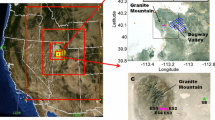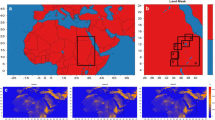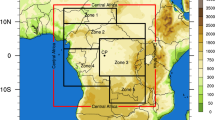Abstract
We evaluated the performance of the three-dimensional Weather Research and Forecasting (WRF) mesoscale model, specifically the performance of the planetary boundary-layer (PBL) parametrizations. For this purpose, Cabauw tower observations were used, with the study extending beyond the third GEWEX Atmospheric Boundary-Layer Study (GABLS3) one-dimensional model intercomparison. The WRF model (version 3.4.1) contains 12 different PBL parametrizations, most of which have been only partially evaluated. The GABLS3 case offers a clear opportunity to evaluate model performance, focusing on time series of near-surface weather variables, radiation and surface flux budgets, vertical structure and the nighttime inertial oscillation. The model results revealed substantial differences between the PBL schemes. Generally, non-local schemes tend to produce higher temperatures and higher wind speeds than local schemes, in particular, for nighttime. The WRF model underestimates the 2-m temperature during daytime (about \(2\) K) and substantially underestimates it at night (about \(4\) K), in contrast to the previous studies where modelled 2-m temperature was overestimated. Considering the 10-m wind speed, during the night turbulent kinetic energy based schemes tend to produce lower wind speeds than other schemes. In all simulations the sensible and latent heat fluxes were well reproduced. For the net radiation and the soil heat flux we found good agreement with daytime observations but underestimations at night. Concerning the vertical profiles, the selected non-local PBL schemes underestimate the PBL depth and the low-level jet altitude at night by about 50 m, although with the correct wind speed. The latter contradicts most previous studies and can be attributed to the revised stability function in the Yonsei University PBL scheme. The local, turbulent kinetic energy based PBL schemes estimated the low-level jet altitude and strength more accurately. Compared to the observations, all model simulations show a similar structure for the potential temperature, with a consistent cold bias (\(\approx \)2 K) in the upper PBL. In addition to the sensitivity to the PBL schemes, we studied the sensitivity to technical features such as horizontal resolution and domain size. We found a substantial difference in the model performance for a range of 12, 18 and 24 h spin-up times, longer spin-up time decreased the modelled wind speed bias, but it strengthened the negative temperature bias. The sensitivity of the model to the vertical resolution of the input and boundary conditions on the model performance is confirmed, and its influence appeared most significant for the non-local PBL parametrizations.










Similar content being viewed by others
References
Atlaskin E, Vihma T (2012) Evaluation of NWP results for wintertime nocturnal boundary-layer temperatures over Europe and Finland. Q J R Meteorol Soc 138(667):1440–1451
Baas P, Bosveld FC, Holtslag AAM (2009) A climatology of nocturnal low-level jets at cabauw. J Appl Meteorol Climatol 48(8):1627–1642
Baas P, Bosveld FC, Lenderink G, van Meijgaard E, Holtslag AAM (2010) How to design single-column model experiments for comparison with observed nocturnal low-level jets. Q J R Meteorol Soc 136(648):671–684
Banta R (2008) Stable-boundary-layer regimes from the perspective of the low-level jet. Acta Geophys 56:58–87
Beljaars ACM, Bosveld FC (1997) Cabauw data for the validation of land surface parameterization schemes. J Clim 10(6):1172–1193
Bosveld F, Baas P, Steeneveld GJ, Holtslag A, Angevine W, Bazile E, de Bruijn E, Deacu D, Edwards J, Ek M, Larson V, Pleim J, Raschendorfer M, Svensson G (2014a) The GABLS third intercomparison case for boundary layer model evaluation: part B: results and process understanding. Boundary-Layer Meteorol (this issue)
Bosveld F, Baas P, van Meijgaard E, de Bruijn E, Steeneveld GJ, Holtslag A (2014b) The GABLS third intercomparison case for boundary layer model evaluation: part A: case selection and set-up. Boundary-Layer Meteorol (this issue)
Bougeault P, Lacarrere P (1989) Parameterization of orography-induced turbulence in a mesobeta-scale model. Mon Weather Rev 117(8):1872–1890
Carvalho D, Rocha A, Gómez-Gesteira M, Santos C (2012) A sensitivity study of the WRF model in wind simulation for an area of high wind energy. Environ Modell Softw 33:23–34
Chen F, Dudhia J (2001) Coupling an advanced land surface-hydrology model with the Penn State-NCAR MM5 modeling system. Part I: model implementation and sensitivity. Mon Weather Rev 129:569–585
Chimonas G, Nappo C (1989) Wave drag in the planetary boundary layer over complex terrain. Boundary-Layer Meteorol 47:217–232
Chou S-H (2011) An example of vertical resolution impact on WRF-Var analysis. Electron J Oper Meteorol 12:1–20
Cuxart J, Holtslag A, Beare R, Bazile E, Beljaars A, Cheng A, Conangla L, Ek M, Freedman F, Hamdi R, Kerstein A, Kitagawa H, Lenderink G, Lewellen D, Mailhot J, Mauritsen T, Perov V, Schayes G, Steeneveld G-J, Svensson G, Taylor P, Weng W, Wunsch S, Xu K-M (2006) Single-column model intercomparison for a stably stratified atmospheric boundary layer. Boundary-Layer Meteorol 118(2):273–303
de Haij M, Wauben W, Klein Baltink H (2006) Determination of mixing layer height from ceilometer backscatter profiles. In: Proceedings of SPIE, vol 6362, Stockholm, Sweden
Dudhia J (1989) Numerical study of convection observed during the winter monsoon experiment using a mesoscale two-dimensional model. J Atmos Sci 46:3077–3107
Dyer A (1974) A review of flux–profile relationships. Boundary-Layer Meteorol 7(3):363–372
Ek MB, Mitchell KE, Lin Y, Rogers E, Grunmann P, Koren V, Gayno G, Tarpley JD (2003) Implementation of Noah land surface model advances in the National Centers for Environmental Prediction operational mesoscale Eta model. J Geophys Res Atmos 108(D22):8851
García-Díez M, Fernández J, Fita L, Yagüe C (2013) Seasonal dependence of WRF model biases and sensitivity to PBL schemes over Europe. Q J R Meteorol Soc 139(671):501–514
Gego E, Hogrefe C, Kallos G, Voudouri A, Irwin J, Rao S (2005) Examination of model predictions at different horizontal grid resolutions. Environ Fluid Mech 5(1–2):63–85
Grachev AA, Fairall CW, Persson POG, Andreas EL, Guest PS (2005) Stable boundary-layer scaling regimes: the SHEBA data. Boundary-Layer Meteorol 116(2):201–235
Guichard F, Parsons DB, Dudhia J, Bresch J (2003) Evaluating mesoscale model predictions of clouds and radiation with SGP ARM data over a seasonal timescale. Mon Weather Rev 131(5):926–944
Holtslag A (2006) GEWEX Atmospheric Boundary-Layer Study (GABLS) on stable boundary layers. Boundary-Layer Meteorol 118(2):234–246
Holtslag AAM, Svensson G, Baas P, Basu S, Beare B, Beljaars ACM, Bosveld FC, Cuxart J, Lindvall J, Steeneveld GJ, Tjernström M (2013) Stable atmospheric boundary layers and diurnal cycles—challenges for weather and climate models. Bull Am Meteorol Soc 94:1691–1706
Hong S-Y, Pan H-L (1996) Nonlocal boundary layer vertical diffusion in a medium-range forecast model. Mon Weather Rev 124(10):2322–2339
Hong S, Noh Y, Dudhia J (2006) A new vertical diffusion package with an explicit treatment of entrainment processes. Mon Weather Rev 134(9):2318–2341
Hu X-M, Nielsen-Gammon JW, Zhang F (2010) Evaluation of three planetary boundary layer schemes in the WRF model. J Appl Meteorol Climatol 49(9):1831–1844
Janjic ZI (1990) The step-mountain coordinate: physical package. Mon Weather Rev 118(7):1429–1443
Janjic ZI (1996) The surface layer in the NCEP Eta Model. In: 11th Conference on numerical weather prediction. American Meteorological Society, Boston, pp 354–355
Janjic ZI (2002) Nonsingular Implementation of the Mellor-Yamada Level 2.5 Scheme in the NCEP Meso model. Technical report, NCEP
Jankov I, Gallus WA Jr, Segal M, Koch SE (2007) Influence of initial conditions on the WRF-ARW Model QPF response to physical parameterization changes. Weather Forecast 22(3):501–519
Jiménez PA, Dudhia J (2012) Improving the representation of resolved and unresolved topographic effects on surface wind in the WRT model. J Appl Meteorol Climatol 51(2):300–316
Jin J, Miller NL, Schlegel N (2010) Sensitivity study of four land surface schemes in the WRF model. Adv Meteorol 2010:1–11
LeMone MA, Tewari M, Chen F, Dudhia J (2012) Objectively determined fair-weather CBL depths in the ARW-WRF model and their comparison to CASES-97 observations. Mon Weather Rev 141(1):30–54
Liu G, Liu Y, Endo S (2012) Evaluation of surface flux parameterizations with long-term ARM observations. Mon Weather Rev 141(2):773–797
Lothon M, Lenschow DH (2010) Studying the afternoon transition of the planetary boundary layer. Eos Trans AGU 91(29):253–254
Mahrt L (1999) Stratified atmospheric boundary layers. Boundary-Layer Meteorol 90:375–396
Mass CF, Ovens D, Westrick K, Colle BA (2002) Does increasing horizontal resolution produce more skillful forecasts? Bull Am Meteorol Soc 83(3):407–430
Mellor GL, Yamada T (1974) A hierarchy of turbulence closure models for planetary boundary layers. J Atmos Sci 31:1791–1806
Mellor GL, Yamada T (1982) Development of a turbulence closure model for geophysical fluid problems. Rev Geophys 20(4):851–875
Mlawer EJ, Taubman SJ, Brown PD, Iacono MJ, Clough SA (1997) Radiative transfer for inhomogeneous atmospheres: RRTM, a validated correlated-k model for the longwave. J Geophys Res Atmos 102(14):16663–16682
Morcrette JJ, Geleyn JF (1985) On the influence of different radiation parametrizations on model-generated radiation fields. Q J R Meteorol Soc 111(468):565–585
Nakanishi M (2001) Improvement of the Mellor–Yamada turbulence closure model based on large-eddy simulation data. Boundary-Layer Meteorol 99(3):349–378
Nakanishi M, Niino H (2004) An improved Mellor–Yamada level-3 model with condensation physics: its design and verification. Boundary-Layer Meteorol 112(1):1–31
Nieuwstadt FTM (1984) The turbulent structure of the stable nocturnal boundary layer. J Atmos Sci 41(14):2202–2216
Pleim JE (2007a) A combined local and nonlocal closure model for the atmospheric boundary layer. Part I: model description and testing. J Appl Meteorol Climatol 46(9):1383–1395
Pleim JE (2007b) A combined local and nonlocal closure model for the atmospheric boundary layer. Part II: application and evaluation in a mesoscale meteorological model. J Appl Meteorol Climatol 46(9):1396–1409
Pleim JE, Chang JS (1992) A non-local closure model for vertical mixing in the convective boundary layer. Atmos Environ Part A 26(6):965–981
Savijärvi H (2006) Radiative and turbulent heating rates in the clear-air boundary layer. Q J R Meteorol Soc 132(614):147–161
Seth A, Rojas M (2003) Simulation and sensitivity in a nested modeling system for South America. Part I: reanalyses boundary forcing. J Clim 16(15):2437–2453
Shin H, Hong S-Y (2011) Intercomparison of planetary boundary-layer parametrizations in the WRF model for a single day from CASES-99. Boundary-Layer Meteorol 139(2):261–281
Skamarock WC (2004) Evaluating mesoscale NWP models using kinetic energy spectra. Mon Weather Rev 132(12):3019–3032
Skamarock WC, Klemp JB (2008) A time-split nonhydrostatic atmospheric model for weather research and forecasting applications. J Comput Phys 227(7):3465–3485
Steeneveld GJ, Vilà-Guerau de Arellano J, Holtslag A, Mauritsen AAM, Svensson G, de Bruijn EIF (2008) Evaluation of limited-area models for the representation of the diurnal cycle and contrasting nights in CASES-99. J Appl Meteorol Climatol 47(3):869–887
Steeneveld GJ, Tolk LF, Moene AF, Hartogensis OK, Peters W, Holtslag AAM (2011) Confronting the WRF and RAMS mesoscale models with innovative observations in the Netherlands: evaluating the boundary layer heat budget. J Geophys Res Atmos 116(D23):D23114
Sterk HAM, Steeneveld GJ, Holtslag AAM (2013) The role of snow-surface coupling, radiation, and turbulent mixing in modeling a stable boundary layer over Arctic sea ice. J Geophys Res Atmos 118(3):1199–1217
Sukoriansky S (2008) Implementation of the Quasi-Normal Scale Elimination (QNSE) model of stably stratified turbulence in WRF. Technical report, Report on WRF-DTC Visit, Developmental Testbed Center
Sukoriansky S, Galperin B, Perov V (2005) Application of a new spectral theory of stably stratified turbulence to the atmospheric boundary layer over sea ice. Boundary-Layer Meteorol 117(2):231–257
Sukoriansky S, Galperin B, Perov V (2006) A quasi-normal scale elimination model of turbulence and its application to stably stratified flows. Nonlinear Process Geophys 13(1):9–22
Svensson G, Holtslag A, Kumar V, Mauritsen T, Steeneveld G, Angevine W, Bazile E, Beljaars A, Bruijn E, Cheng A, Conangla L, Cuxart J, Ek M, Falk M, Freedman F, Kitagawa H, Larson V, Lock A, Mailhot J, Masson V, Park S, Pleim J, Söderberg S, Weng W, Zampieri M (2011) Evaluation of the diurnal cycle in the atmospheric boundary layer over land as represented by a variety of single-column models: the second GABLS experiment. Boundary-Layer Meteorol 140(2):177–206
Teixeira J, Stevens B, Bretherton CS, Cederwall R, Klein SA, Lundquist JK, Doyle JD, Golaz JC, Holtslag AAM, Randall DA, Siebesma AP, Soares PMM (2008) Parameterization of the atmospheric boundary layer: a view from just above the inversion. Bull Am Meteorol Soc 89(4):453–458
Troen IB, Mahrt L (1986) A simple model of the atmospheric boundary layer: sensitivity to surface evaporation. Boundary-Layer Meteorol 37(1–2):129–148
U.S. Geological Survey (2011) U.S. Geological Survey home page. Accessed 6 May 2011
Van de Wiel BJH, Moene AF, Steeneveld GJ, Baas P, Bosveld FC, Holtslag AAM (2010) A conceptual view on inertial oscillations and nocturnal low-level jets. J Atmos Sci 67(8):2679–2689
Van der Velde IR, Steeneveld GJ, Holtslag AAM (2010) Modeling and forecasting the onset and duration of severe radiation fog under frost conditions. Mon Weather Rev 138(11):4237–4253
Van Ulden AP, Wieringa J (1996) Atmospheric boundary layer research at Cabauw. Boundary-Layer Meteorol 78(1–2):39–69
Vannitsem S, Chomé F (2005) One-way nested regional climate simulations and domain size. J Clim 18(1):229–233
Vogelezang DHP, Holtslag AAM (1996) Evaluation and model impacts of alternative boundary-layer height formulations. Boundary-Layer Meteorol 81:245–269
Yang Y, Uddstrom M, Duncan M (2011) Effects of short spin-up periods on soil moisture simulation and the causes over New Zealand. J Geophys Res Atmos 116(D24):D24108
Zhang D-L, Zheng W-Z (2004) Diurnal cycles of surface winds and temperatures as simulated by five boundary layer parameterizations. J Appl Meteorol 43(1):157–169
Zhong S, In H, Clements C (2007) Impact of turbulence, land surface, and radiation parameterizations on simulated boundary layer properties in a coastal environment. J Geophys Res Atmos 112(D13):D13110
Acknowledgments
The first author acknowledges funding from the NWO-ALW project “Quantifying the role of nocturnal small-scale orographic wave drag on near-surface weather and climate over land”, project number 820.01.004 and the project NWO-Computer time SH-060-12. The contribution by G.J. Steeneveld has partly been sponsored by the NWO contract 863.10.010 (Lifting the fog). We would like to thank KNMI, especially Fred Bosveld for making the observations available and Jordi Vilà and Marina Sterk for their valuable comments. We also thank the reviewers for their constructive suggestions.
Author information
Authors and Affiliations
Corresponding author
Rights and permissions
About this article
Cite this article
Kleczek, M.A., Steeneveld, GJ. & Holtslag, A.A.M. Evaluation of the Weather Research and Forecasting Mesoscale Model for GABLS3: Impact of Boundary-Layer Schemes, Boundary Conditions and Spin-Up. Boundary-Layer Meteorol 152, 213–243 (2014). https://doi.org/10.1007/s10546-014-9925-3
Received:
Accepted:
Published:
Issue Date:
DOI: https://doi.org/10.1007/s10546-014-9925-3




